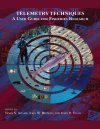Handbook / Manual
By: Noah S Adams(Editor), John W Beeman(Editor), John H Eiler(Editor)
543 pages, colour & b/w photos, colour & b/w illustrations, tables
![Telemetry Techniques Telemetry Techniques]()
Click to have a closer look
About this book
Contents
Customer reviews
Related titles
About this book
Telemetry provides a powerful and flexible tool for studying fish and other aquatic animals, and its use has become increasingly commonplace. However, telemetry is gear intensive and typically requires more specialized knowledge and training than many other field techniques. As with other scientific methods, collecting good data is dependent on an understanding of the underlying principles behind the approach, knowing how to use the equipment and techniques properly, and recognizing what to do with the data collected.
Telemetry Techniques provides a road map for using telemetry to study aquatic animals, and provides the basic information needed to plan, implement, and conduct a telemetry study under field conditions. Topics include acoustic or radio telemetry study design, tag implantation techniques, radio and acoustic telemetry principles and case studies, and data management and analysis.
Chapters are written by biologists, technicians, and engineers from the private, academic, and government sectors, with decades of experience using these technologies.
Contents
Introduction and Overview
1 Introduction
2 A History of Telemetry in Fishery Research (Eric E. Hockersmith and John W. Beeman)
3 Designing Studies Based on Acoustic or Radio Telemetry (John D. Koehn)
4 Techniques for Telemetry Transmitter Attachment and Evaluation of Transmitter Effects on Fish Performance (Theresa L. Liedtke and A. Michelle Wargo Rub)
5. Radio Telemetry-Principles and Practice
5.1 Radio Telemetry in Fresh Water: the Basics (Valerian B. Kuechle and Peter J. Kuechle)
5.2 Optimization of Radio Telemetry Receiving Systems (Scott D. Evans and John R. Stevenson)
5.3 Tracking Aquatic Animals with Radio Telemetry (John H. Eiler)
6. Radio Telemetry-Case Studies
6.1 Two Case Studies from Washington’s Olympic Peninsula: Radio Telemetry Reveals Bull Trout Anadromy and Establishes Baseline Information Prior to Dam Removal (Stephen C. Corbett and Samuel J. Brenkman)
6.2 Radio Tracking of African Cichlids in a Large Floodplain River: Challenges and Results from the Zambezi River in Namibia (Eva B. Thorstad, Clinton J. Hay, Finn Økland, and Tor F. Næsje)
6.3 The Application of Radio Telemetry to Fisheries Research in Brazil’s Large Rivers (Lisiane Hahn)
6.4 Tracking Aquatic Animals in Lakes and Analyzing the Telemetry Data (Jim Winter)
6.5 Design and Performance of Radio Telemetry Systems for Assessing Juvenile Fish Passage at Three Hydroelectric Dams (John W. Beeman, Eric E. Hockersmith, and John R. Stevenson)
7. Acoustic Telemetry-Principles and Practice
7.1 Acoustic Telemetry Overview (Douglas G. Pincock and Samuel V. Johnston)
7.2 Detection Efficiency in Telemetry Studies: Definitions and Evaluation Methods (Michael C. Melnychuk)
8. Acoustic Telemetry-Case Studies
8.1 Use of Acoustic Telemetry to Evaluate Survival and Behavior of Juvenile Salmonids at Hydroelectric Dams: a Case Study from Rocky Reach Dam, Columbia River, USA (Tracey Steig and Christopher Holbrook)
8.2 Considerations for Tagging and Tracking Fish in Tropical Coastal Habitats: Lessons from Bonefish, Barracuda, and Sharks Tagged with Acoustic Transmitters (Karen J. Murchie, Andy J. Danylchuk, Steven J. Cooke, Amanda C. O’Toole, Aaron Schultz, Chris Haak, Edward J. Brooks, and Cory D. Suski)
8.3 Ontogeny of a Sonic Telemetry Program for Atlantic Salmon Salmo salar (Fred G. Whoriskey)
9. Data Management and Analysis
9.1 Time-to-Event Analysis as a Framework for Quantifying Fish Passage Performance (Theodore Castro-Santos and Russell W. Perry)
9.2 Using Mark-Recapture Models to Estimate Survival from Telemetry Data (Russell W. Perry, Theodore Castro-Santos, Christopher M. Holbrook, and Benjamin P. Sandford)
9.3 Developing a Quality Assurance Plan for Telemetry Studies: a Necessary Management Tool for an Effective Study (Jill M. Hardiman, Chris E. Walker, and Tim D. Counihan)
9.4 Database Management and “Real-Time” Data Analysis Systems for Fish Telemetry Studies (Karl K. English, Dave Robichaud, and Peter Wainwright)
9.5 Bias from False-Positive Detections and Strategies for their Removal in Studies Using Telemetry (John W. Beeman and Russell W. Perry)
Index
Customer Reviews
Handbook / Manual
By: Noah S Adams(Editor), John W Beeman(Editor), John H Eiler(Editor)
543 pages, colour & b/w photos, colour & b/w illustrations, tables


































